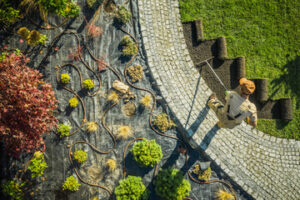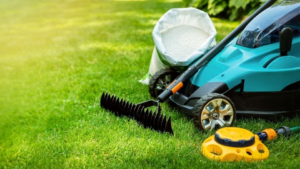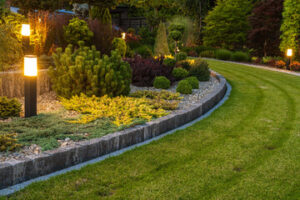A high-quality hardscaping project adds beauty to your property and increases its value. It also eliminates the need for traditional mowing, trimming and weeding.

It is important that your hardscapes blend with their surroundings – this can be the natural world or the style of your home. Hardscapes Greensboro NC include patios, walkways, sitting walls, water features, fire pits and landscape lighting.
Whether made of concrete, brick pavers or flagstone, patios offer versatile outdoor living areas for relaxing and entertaining. They can be enhanced by incorporating seating walls, walkways and water features. Patios are ideal for homeowners that entertain frequently or want to expand the usable space of their landscapes.
Driveways are another hardscape element that can enhance the functionality of your home’s exterior. They provide a durable surface for parking vehicles and reduce maintenance work such as weed removal, mowing, and edging. They can also be incorporated into the design to define specific areas of your garden.
Retaining walls are a common feature that can be added to gardens to create planting areas or convert a sloped yard into usable space. They also provide the ability to install a deck or patio.
Other hardscape features include fire pits and outdoor lighting. These can be used to increase the entertainment possibilities of your outdoor spaces after the sun goes down and create a festive ambiance during winter gatherings.
It is important to balance hardscape and softscape elements so that they appear as one cohesive picture, rather than a disconnected series of features. A well-designed landscape can make all the difference in how you use your outdoor spaces, improve your home’s curb appeal and boost its resale value. Landscape professionals can help you determine the best hardscape options for your needs.
Walkways
As the name suggests, walkways are paths that connect your outdoor spaces. Paths are a crucial part of any landscape, offering an unchanging focal point that contrasts against all of the greenery. They can be designed from many different materials, but pavers are an excellent option. They are available in a range of colors and shapes, giving you the freedom to create a walkway that is as unique as your home.
In addition to aesthetics, well-designed hardscape walkways help to prevent slips and falls by directing pedestrian traffic on an even surface. They also protect bare soil from erosion and allow for a natural look in areas of high foot traffic. Moreover, they can be designed to include a variety of features, including tree grates, water-clearing trench drains, stormwater grates, detectable warning plates, bollards, lids and frames.
Depending on where your walkways are located, it is important to make sure they receive adequate sunlight. This will help to prevent the growth of mold, mildew and other fungus that can occur in damp or shaded areas.
A walkway can be created from a wide variety of materials, but flagstone and concrete pavers are popular choices. They are relatively inexpensive and are available in a number of colors, styles and patterns. Alternatively, gravel is a great choice for its durability and permeability. Decomposed granite (DG) is another affordable material that feels soft underfoot and can be combined with shrubs to create an attractive edging.
Retaining Walls
Retaining walls serve a functional purpose, keeping soil in place and preventing it from eroding. They can also be used to terrace a slope, creating an area for planting and improving the overall aesthetic of a landscape design. Retaining walls come in many different styles, from natural-looking structures made with large rounded rocks to those with a more modern feel and intricate stone veneers.
A hardscape can create a relaxing space for entertaining friends and family, a beautiful place to enjoy the flowers in your garden or simply a spot to relax with a book on a sunny day. By adding a patio or walkway, you will be able to extend the amount of time you can spend in your outdoor space.
Your hardscapes should always be paired with softscape features to create a balance in your landscape. Water features are an important part of a balanced design, as they can provide a cooling effect and add visual interest. They can also reduce the need for chemical-based lawn care, allowing you to enjoy your landscaping without the hassle of pesticides or fertilizers.
A well-designed hardscape can boost the curb appeal of your property and increase its resale value. By adding elements such as paths, seating areas, fire pits and landscape lighting to your yard, you will have a space that serves a variety of purposes, making it a comfortable and enjoyable place for everyone in the family.
Water Features
Adding water features like fountains and ponds adds a soothing, relaxing element to your landscape. A well-designed waterfall or koi pond is an artful addition to your yard that will also create a natural habitat for birds and aquatic life. Water features can also be made from a variety of materials and construction methods, from simple stone to more elaborate stonework and concrete, allowing for a wide range of styles that reflect the Upstate’s diverse cultural heritage.
The water feature can have any number of elements, such as dumping buckets, dancing water jets or waterfalls. The water can even be sent cascading down a rock wall, creating a dramatic, tropical feel to your pool.
From a water management perspective, hardscape features need to have some sort of drainage system. Since urban landscapes are covered in impervious surfaces that don’t absorb water, they require artificial ways to manage stormwater runoff. Failure to do so results in flooding, soil erosion and other environmental problems, including wet rot to wood elements, basement flooding, sinkholes, accelerated wear to driveways or sidewalks, and mosquito breeding.
The most common hardscapes include garden edging, steps and walkways, decking and patios, retaining walls, waterscapes, and fire pits. They are non-living parts of the landscape and can be built with a variety of materials such as pavers, stone, blocks and concrete. They can be complemented by a variety of softscapes, such as grass, shrubs, flowers and trees.
Outdoor Lighting
Adding outdoor lighting is an excellent way to extend the functional use of your hardscape features. Lights can brighten walkways for safer navigation, illuminate retaining walls and highlight water features or other points of interest to increase the beauty of your landscape after dark. Lights can also deter crime by illuminating dark areas of your property and help to keep your family safe from intruders. Choose from flood lights that switch on at night and are activated by motion sensors to a variety of wall pack lighting options for greater control.
A hardscape gazebo is an excellent way to enhance the value and beauty of your landscape while providing you with a private retreat or living area. Gazebos are great for relaxing, entertaining, meditation and yoga or simply a place to escape with a good book. Creating a gazebo out of the right materials ensures that your hardscape will stand up to the demands of the landscape and your family for years to come.
Hardscape materials like concrete, pavers, brick and natural stone each offer unique benefits and styles. It is important to take into account your project needs, location and budget when determining what material to select. For example, some materials are better suited to specific climates and require more maintenance than others. In addition, some hardscapes require special considerations for safety and installation, such as steps or retaining walls.
Fire Pits
A well-designed fire pit transforms a garden into an inviting living space. Families gather around it to roast marshmallows or adults enjoy cocktails and conversations into the evening. Choose a wood-burning model for a classic feel or opt for gas-fueled fire pits like those from Solo Stove and Outland that provide quick ignition and easy control. Fire pit accessories can include safety screens, covers and built-in seating.
Each of the smokeless fire pits we tested burns wood in a way that produces minimal visible emissions and heat. They also produce a good amount of radiant heat that helps keep people warm. Most have raised metal strips that act as a wood grate to increase initial airflow and prevent ash from burning. Our favorite, the Sunnydaze Cosmic Fire Pit, has a celestial moon and stars cutout around the fire bowl that shines when lit. It took the longest to assemble of all the pits we tested but did so with detailed and intuitive instructions. It also includes a mesh cover, short fire poker and a grate removal tool.
When choosing a fire pit, remember that wood smoke can cause irritation for those with asthma and other respiratory conditions. Also, local code may dictate where wood fire pits can be located or whether they are allowed at all. Check with your fire or building department to see what the requirements are for your area.

